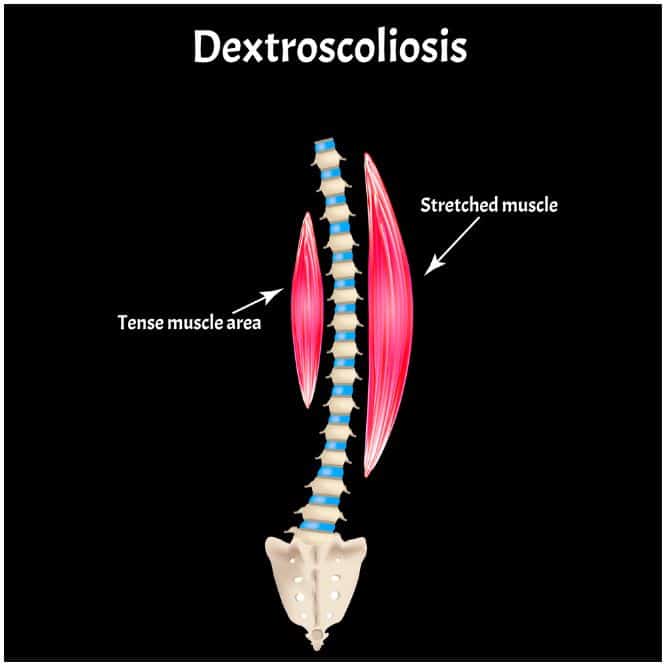Dextroscoliosis
It is a condition where the spinal is curved to the right (“dextro” translates as right) part of the body. This type of scoliosis commonly develops in the upper areas of the back (better known as the thoracic spine) and it is the most common type of curve.
Since the curve is to the right, it may impact the rib cage on the right and cause problems with the lungs and kidney.
This condition affects both males and females; however, the spinal area of women is more sensitive. On average, patients with a type of scoliosis suffer about 14 years reduction in their life expectancy, because of the reduced amount of oxygen supplied to the body.
Symptoms
- pain in the back (the majority of patients report feeling pain, that is also the main concern for many sufferers);
- individuals with severe cases of this condition may suffer from numbness in the body, breathing difficulties, trouble walking, and gastrointestinal problems;
- one shoulder may be higher than the other;
- one hip may be higher than the other;
- rib prominence.
Note – the symptoms of this condition considerably depend on how much it has progressed and the severity of the curvature.
Causes
- it may be present at birth (congenital) as a result of a malformation of the child’s spine between the 3rd and 6th week of pregnancy;
- neuromuscular disorders and diseases, like – muscular dystrophy or cerebral palsy (a condition that affects movement, muscle tone, and motor skills). They are known to be the causes of approximately 20 percent of the cases.
Note – many cases are idiopathic, meaning that there is no known cause.
Diagnosis
To diagnose this disease, sufferers need an MRI scan, spine X-Ray (during the X-rays, the patient will be asked to hold certain positions while lying or standing on a table), and CT scan.
Treatment
The treatment includes exercises designed to strengthen and stabilize the muscles of the back, while at the same time keeping the spinal column mobile. Physical exercises are also useful since they allow the sufferer to have a normal life.
Children who have this condition are usually monitored closely with X-rays, to observe if the curve is getting worse. If the curve is over thirty degrees, and the sufferer is very young, bracing is started immediately.
Surgery may also be required in the future. Because this type of surgery is complex and carries a high risk of complications, it is generally considered only after all other options have been exhausted.
Surgery will not be recommended for most patients, especially in curves of less than forty degrees. Moreover, in adults, a curve of 20 degrees is not treated since is considered just at the limit for the definition of scoliosis.
Levoscoliosis
It is a clinical condition where a section of the spine is abnormally curved to the left region of the body. Usually, the curve occurs in the lower portion of the back,
Symptoms
- one arm hanging lower than the other;
- one leg may appear shorter than the other;
- one shoulder higher than the other;
- head not being centered over the body.
Causes
- congenital – it is usually associated with other organ defects, and it is caused by a congenital abnormal formation of the bones of the spine;
- neuromuscular – the nerves which go into the muscles that hold up the spine are not controlled properly;
- idiopathic – in these patients, the cause is unknown, and the sufferers appear to be healthy otherwise;
- back injury.
Diagnosis
A healthcare specialist can diagnose this problem with a physical exam including an X-Ray to be 100 percent of the findings.
Treatment
It may include a brace, physical therapy, or surgery.
Bottom Line – Dextroscoliosis vs Levoscoliosis
A person’s spine can have both these conditions, but levoscoliosis can be a bit more problematic than dextroscoliosis since the heart is on the left side of the body.
Prevention
Note – the vast majority of cases with these conditions, particularly those which occur in childhood, cannot be prevented. However, the progression can occasionally be notably curtailed. Nevertheless, the cases which occur later in life can be prevented by following these recommendations:
Sleep
Sleeping with these conditions can be quite a challenge. It is recommended not to sleep on your stomach since it is the worst position to sleep due to the fact that it causes the thoracic spine to become flattered.
READ MORE: Bed Bug Bites vs Mosquito Bites
Physical Exercise
It is being recommended more and more as an alternative treatment for mild scoliosis. By performing special exercises for these conditions, you may be able to decrease the pain you feel as a result of your scoliosis and slow the curvature of the spine.
Moreover, physical exercise can help you maintain a healthy weight, which can lower the strain on your back. Also, physical activities that stretch and strengthen your back may help to prevent other back problems.
Eat Anti-Inflammatory Foods
Anti-inflammatory foods include – blueberries, oranges, peppers, turmeric, pineapples, pears, beets, oatmeal, spinach, lentils, mung beans, kale, cabbage, carrots, cauliflower, strawberries, walnuts, almonds, chickpeas, red kidney beans, chia seeds, flax seeds, sesame seeds, broccoli, apples, mangoes, papayas, ginger, tomatoes, or cherries.
READ THIS NEXT: Sprite vs 7up
References http://www.umm.edu/programs/spine/health/guides/adult-scoliosis https://www.ncbi.nlm.nih.gov/pmc/articles/PMC3011182/
